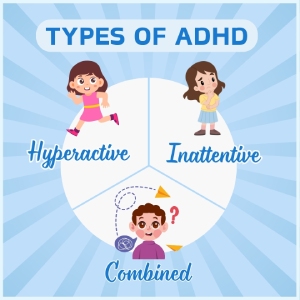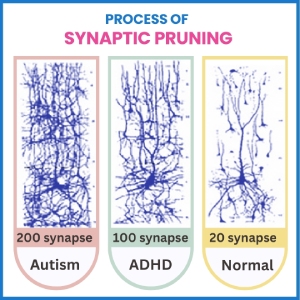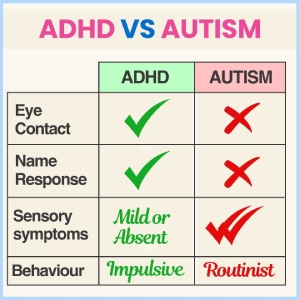
This is a vital topic that confuses many parents, and due to a lack of knowledge, they often make irreparable mistakes in the treatment of autism. In this article, we will highlight the importance of understanding Attention Deficit Hyperactivity Disorder (ADHD) and its relationship with Autism. While these disorders can sometimes coexist, they are distinct in their characteristics and impact on a child.
ADHD, or Attention Deficit Hyperactivity Disorder, is a condition marked by a child’s difficulty in focusing on tasks and an increased tendency to get distracted. This is known as attention deficit. Children with ADHD often struggle to concentrate on their studies, have a short attention span, and can become easily distracted by minor distractions. For example, even a faint sound, like someone dropping a pencil in school, can disrupt their focus, making it challenging for them to stay focused on study.

1.SENSITIVITY
While both autism and ADHD involve challenges with attention, the nature and extent of these challenges differ significantly. Let us understand this difference with an example of the decibels of sound that a child is sensitive about. (the numbers are just indicative for study purposes)
So, the main difference between ADHD and autism is the sensitivity and reaction to various sensory stimulus. While a normal child exhibits almost nil sensitivity to sensory stimulus, a child with autism exhibits a multiplefold increased sensitivity to sensory stimulus and a child with ADHD exhibits a mid-level sensitivity to these sensory stimuli.
To illustrate the differences in sensory sensitivity:

This comparison helps in understanding the varying levels of sensory sensitivity between typical individuals, those with ADHD, and those with autism.
2. DIAGNOSTIC CRITERIA
Another difference between autism and ADHD is to analysis of the associated symptoms also called as the Diagnostic Criteria

So if you see a child who is showing symptoms of Hyperactivity, check the eye contact and the name response. If the child maintains eye contact and responds to a name, he is an ADHD child and vice versa, if the child doesn’t make eye contact and does not respond to a name, he is an Autistic child.
While ADHD shares some features that are common with autism, such as attention difficulty, it is not considered a part of the autism spectrum. ADHD generally presents with less severe sensory sensitivity and has different diagnostic criteria compared to autism.
Interestingly, during the treatment of autism, most children may exhibit ADHD symptoms as part of their recovery process. This means that when the symptoms of autism are reversed, like eye contact is developed, name response is established and the child starts following commands, his hyperactivity increases. Which means now the child falls under the category of ADHD. This is a very good positive sign, indicating that the treatment is effective. However, sometimes parents get misguided and then get unnecessarily worried, making them discontinue treatment. This is a mistake that will halt the reversal of autism. However, for those parents who continue treatment, the reversal of autism continues, and these children eventually show significant improvements and return to a complete recovery leading a normal life.
Understanding the Differences Between ADHD And Autism is essential for accurate diagnosis and effective reversal of autism. Homeopathy, under the guidance of Dr Pravin Jain at HomoeoCARE, offers promising results for managing both conditions. His deeper understanding and connections between autism and ADHD have helped hundreds of parents in reversing autism in their children. Dr Jain provides the best homeopathic treatment for autism and homeopathic treatment for ADHD via offline homeopathic consultations at his Mumbai clinics and online homeopathic consultations via Zoom and WhatsApp for patients around the world. If you have any questions or need further clarification about autism, ADHD, or their treatment, please get in touch with us through WhatsApp.
Copyright ©2021 Homoeocare